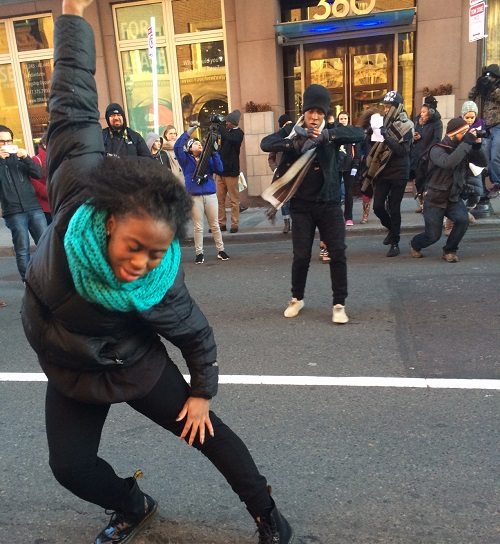
Image Credit: Shafaq Hasan
January 5, 2015;Dig Boston
Young artists from Boston gathered Monday afternoon on busy Newbury Street in a continuation of the Black Lives Matter movement taking place in cities across the country. However, unlike previous demonstrations, Monday’s protest introduced artistic performances as a novel way of engaging a dialogue on police brutality and a broken justice system.
In the bitter cold, about 50 people—students, adults, and stragglers alike—created a circle around performers on Newbury Street and stalled traffic for about 20 minutes. Performances included a somber rendition of “We Ain’t Gonna Stop Till People are Free,” a song that was sung throughout New York last year following the recent shootings of young black men by police officers. Interpretative dancers and even a costumed protestor on stilts set a distinguished tone to the protest.
The protest, complete with a pedestrian-stopping “die-in,” had a strong focus on engaging and informing Boston youth. “I’m here as a young person, a person who is very aware of this epidemic of racism, and an artist in many art forms,” said 18-year-old Nadia Issa, a student activist at Boston Arts Academy and one of the organizers of the demonstration. “I hope this protest engages our young folks to wake up from their material and blinded world.”
Along with Boston’s Youth Against Mass Incarceration, Issa was among the high school students who organized the protest, including fellow Boston Arts Academy student Jeyrie Rodriguez. Students from other local schools, like Boston Green Academy, Codman Academy, Cambridge Rindge, and Boston Latin School, were invited to attend.
A steady drumming, signifying heartbeats, accompanied Rodriguez, 19, as she recited the names of over 100 black men shot and killed by police in the past few years like poetry. With occasional car horns breaking up the rhythm, the protestors concentrated on bringing the group together with song and commentary.
Sign up for our free newsletters
Subscribe to NPQ's newsletters to have our top stories delivered directly to your inbox.
By signing up, you agree to our privacy policy and terms of use, and to receive messages from NPQ and our partners.
Performance as protest is not unique to the Black Lives Matter movement, at least on the surface. The chanting, marching, and communal movement exhibited during protests is a dance of its own. The songs that have emerged, such as the “I Can’t Breathe Anthem,” as well as those brought back from the past (like “Which Side Are You On?”) will be remembered along with the images.

Nor is performance art an unlikely form of protest, either. Last year, NPQ writer Michele Bittner highlighted the thought-provoking performance by artist Tim Youd, who typed Ray Bradbury’s Fahrenheit 451 on a typewriter twenty-four hours a day, seven days a week, during Banned Books week. He then burned the completed book as a physical illustration of censorship. Or take the recent example of Emma Sulkowicz, a Columbia University student carrying her 20-pound mattress around during this school year until her rapist is expelled. Similar to the Black Lives Matter movement, Sulkowicz’s art piece attracted several supporters, many of which volunteered to help her carry her burden, the physical mattress, and maybe even lighten the weight of her assault as well.
Toward the end of her speech, Rodriguez included a quote from civil rights activist Malcolm X that seemed to encompass much of the sentiment surrounding Monday’s protest:
“Look at yourselves. Some of you teenagers, students. How do you think I feel, and I belong to a generation ahead of you—how do you think I feel to have to tell you, ‘We, my generation, sat around like a knot on a wall while the whole world was fighting for its human rights—and you’ve got to be born into a society where you still have that same fight.’ What did we do, who preceded you? I’ll tell you what we did. Nothing. And don’t you make the same mistake we made…”
The raw emotions that often emerge during these types of protests driven by deep, personal stories can be uniquely captured through art. Much like the universal sentiments in this movement, art transcends our boundaries. Perhaps the most striking element of these protests has been the community that has emerged, with people of all walks of life showing their support for the difficult and often personal issue of racism. Art can and should be the shared language for that conversation.—Shafaq Hasan











